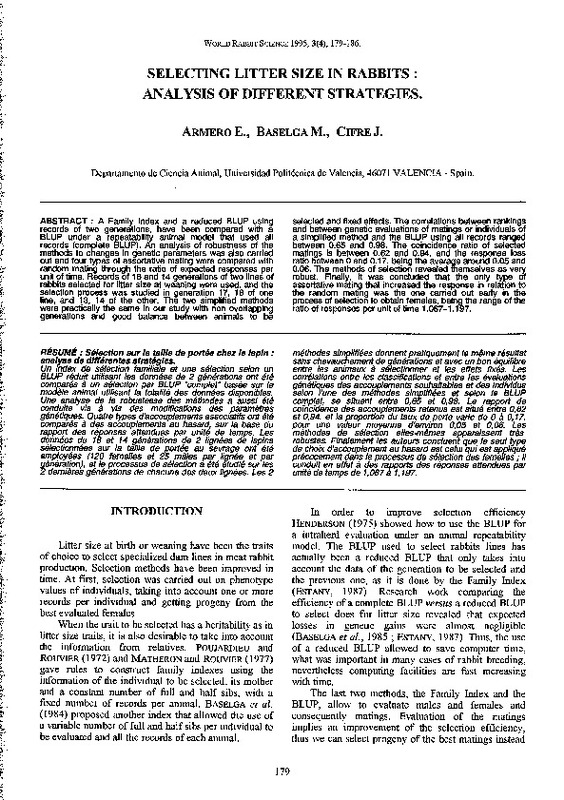JavaScript is disabled for your browser. Some features of this site may not work without it.
Buscar en RiuNet
Listar
Mi cuenta
Estadísticas
Ayuda RiuNet
Admin. UPV
SELECTING LITTER SIZE IN RABBITS : ANALYSIS OF DIFFERENT STRATEGIES
Mostrar el registro sencillo del ítem
Ficheros en el ítem
| dc.contributor.author | Armero, E.
|
|
| dc.contributor.author | Baselga, M.
|
|
| dc.contributor.author | Cifre, J.
|
|
| dc.date.accessioned | 2011-03-21T13:54:37Z | |
| dc.date.available | 2011-03-21T13:54:37Z | |
| dc.date.issued | 1995 | |
| dc.identifier.issn | 1257-5011 | |
| dc.identifier.uri | http://hdl.handle.net/10251/10499 | |
| dc.description.abstract | [EN] A Family lndex and a reduced BLUP using records of two generations, have been comparad with a BLUP under a repeatabili!Y animal modal that usad ali records (complete BLUP). An analysis of robustness of the methods to changas in genetic parameters was also carried out and four types of assortative mating were comparad with random mating through the ratio of expected responses per unit of time. Records of 18 and 14 generations of two lines of rabbits selected for litter size at weaning were usad, and the selection process was studied in generation 17, 18 of one line, and 13, 14 of the other. The two simplified methods were practically the sama in our study with non overlapping generations and good balance between animals to be selected and fixed effects. The correlations between rankings and between genetic evaluations of matings or individuals of a simplified method and the BLUP using all records ranged between 0.65 and 0.98. The coincidence ratio of selecled matings is between 0.62 and 0.94, and the response loss ratio l::ietween O and 0.17, being the average around 0.05 and 0.06. The methods of selection revealed themselves as ve~ robust. Finally, it was concluded that the only type of assortative mating that increased the response in relat1on to the random mating was the one carried out early in the process of selection to obtain females, being the range of the ratio of responses per unit of time 1.067-1. t97. | es_ES |
| dc.description.abstract | [FR] Un mdex de sélection familia/e et une sélection selon un BLUP réduit utilisant les données de 2 générations ont été comparés a un sélection par BLUP "complet" basée sur le modele animal utilisant la totalité des données disponibles. Une analyse de la robustesse des méthodes a aussi été conduite vis a vis des modifications des parametres génétiques. Quatre types d'accouplements associatifs ont été comparés a des accouplements au hasarcJ,, sur la base du rapport des réponses attendues par unite de temps. Les données de 18 et 14 générations de 2 lignées de lapins sélectionnées sur la taille de portée au sevrage ont été employées (120 feme/les et 25 mmes par lignée et par génération), et le processus de sélection a été étudié sur les 2 dernieres générations de chacune des deux lignées. Les 2 méthodes simplifiées donnent pratiquement le m{Jme résultat sans chevauchement de générations et avec un bon éguilibre entre les animaux a sélectionner et les effets fixés. Les corrélations entre les classifications et entre les évaluations génétiques des accouplements souhaitables et des individus selon l'une des méthodes simplifiées et selon le BLUP complet, se situent entre 0,65 et 0,98. Le rapport de coincidence des accouplements retenus est situé entre 0,62 et 0,94. et la proportion du taux de perte varie de O a O, 17, pour une vti./eur moyenne d'environ 0,05 et 0,06. Les méthodes de sélect1on elles-m{Jmes apparaissent tres robustes. Finalement les auteurs concluent que le seul type de choix d'accouplement au hasard est celui qui est appllqué précocement dans le processus de sélection des feme/les ; il conduit en effet a des rapports des réponses attendues par unité de temps de 1,067 a 1, 197. | |
| dc.description.sponsorship | This research has been supported by CICYT project AGF94-0577 (Spain) | |
| dc.language | Inglés | es_ES |
| dc.publisher | World Rabbit Science. ICTA. UPV | es_ES |
| dc.relation.ispartof | World Rabbit Science | |
| dc.rights | Reserva de todos los derechos | es_ES |
| dc.title | SELECTING LITTER SIZE IN RABBITS : ANALYSIS OF DIFFERENT STRATEGIES | es_ES |
| dc.type | Artículo | es_ES |
| dc.date.updated | 2011-03-21T13:36:18Z | |
| dc.identifier.doi | 10.4995/wrs.1995.260 | |
| dc.relation.projectID | info:eu-repo/grantAgreement/MEC//AGF94-0577/ES/MEJORA GENETICA Y BIOTECNOLOGIA DE LA REPRODUCCION EN EL CONEJO DE CARNE/ | |
| dc.rights.accessRights | Abierto | es_ES |
| dc.description.bibliographicCitation | Armero, E.; Baselga, M.; Cifre, J. (1995). SELECTING LITTER SIZE IN RABBITS : ANALYSIS OF DIFFERENT STRATEGIES. World Rabbit Science. 3(4). https://doi.org/10.4995/wrs.1995.260 | es_ES |
| dc.description.accrualMethod | SWORD | es_ES |
| dc.relation.publisherversion | https://doi.org/10.4995/wrs.1995.260 | |
| dc.description.volume | 3 | |
| dc.description.issue | 4 | |
| dc.identifier.eissn | 1989-8886 | es_ES |
| dc.contributor.funder | Ministerio de Educación y Ciencia |








